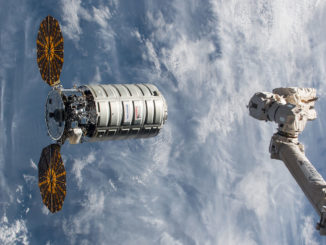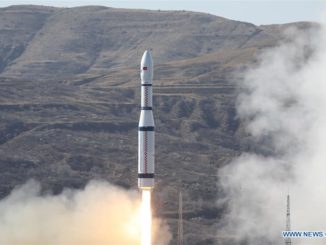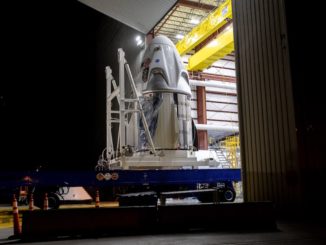Three Russian Gonets communications satellites launched late Wednesday from the Plesetsk Cosmodrome, riding a Soyuz rocket and Fregat upper stage into orbit on the second successful Soyuz mission in less than 24 hours.
The Gonets-M satellites lifted off at 8:14 p.m. EST Wednesday (0114 GMT; 4:14 a.m. Moscow time Thursday) from Plesetsk, a military spaceport in the Arkhangelsk region of northern Russia.
Powered by kerosene-fueled engines generating more than 900,000 pounds of thrust, the Soyuz-2.1b rocket arced toward the north from Plesetsk, targeting a high-inclination orbit tilted 82.5 degrees to the equator.
The rocket shed its four first stage boosters, core stage, and payload fairing in the first few minutes of the flight. A third stage RD-0124 engine finished the Soyuz rocket’s role in the mission before deploying a Fregat upper stage to perform two burns to reach an on-target orbit at an altitude of roughly 932 miles (1,500 kilometers).
Roscosmos, the Russian space agency, confirmed the three Gonets-M communications satellites and a small hitchhiker payload for the Russian Defense Ministry successfully separated from the Fregat upper stage.
The launch from the Plesetsk Cosmodrome came less than 24 hours after a Soyuz rocket and Fregat upper stage lifted off from the Guiana Space Center in South America with a military spy satellite for the United Arab Emirates. That mission was also successful.
There have been 13 flights by Russia’s venerable Soyuz rocket family so far this year.
“Congratulations to all colleagues and partners on the successful launch of three Gonets M spacecraft,” said Pavel Cherenkov, director of the Gonets satellite system for Roscosmos. “According to the information received, their separation from the upper stage took place normally.
“After the specified flight operations are completed, they will be entered into the communication system,” Cherenkov said in a translated statement. “The replenishment of the grouping created an important resource for the viability of the system and created some redundancy opportunities.”

Russian government ministries and civilian authorities use the Gonets-M satellites to relay secure messages between mobile terminals and fixed operators. Gonets means “messenger” in Russian.
The three Gonets-M satellites, each with a prelaunch weight of about 617 pounds (280 kilograms), will undergo orbital checkouts before being commissioned into the data relay network. The spacecraft are designed for five-year missions.
“The Gonets-M satellites will be used for personal communications services, including mobile and fixed communications, industrial, environmental and scientific monitoring in remote regions,” said ISS Reshetnev, manufacturer of the Gonets M satellites.
The Gonets fleet is effective in Russia’s far northern regions out of reach of conventional satellite communications systems. Messages relayed by the Gonets network are transmitted from the ground to a satellite passing overhead, then stored in the craft’s memory until it flies over the message’s recipient.
The Gonets system is operated by a public-private partnership between Roscosmos — the Russian space agency — and Russian industry.

With the addition of three new Gonets-M satellites, the data relay system now consists of 15 satellites, tweeted Dmitry Rogozin, head of Roscosmos.
A Soyuz launch in September also launched three Gonets-M satellites, giving the network six fresh relay stations in the last three months.
The secondary payload launched by the Soyuz rocket was a nanosatellite named ERA-1 for the Russian Ministry of Defense. The small military satellite will test “advanced microdevices and microsystems” for attitude control and navigation, Roscosmos said.
Email the author.
Follow Stephen Clark on Twitter: @StephenClark1.



